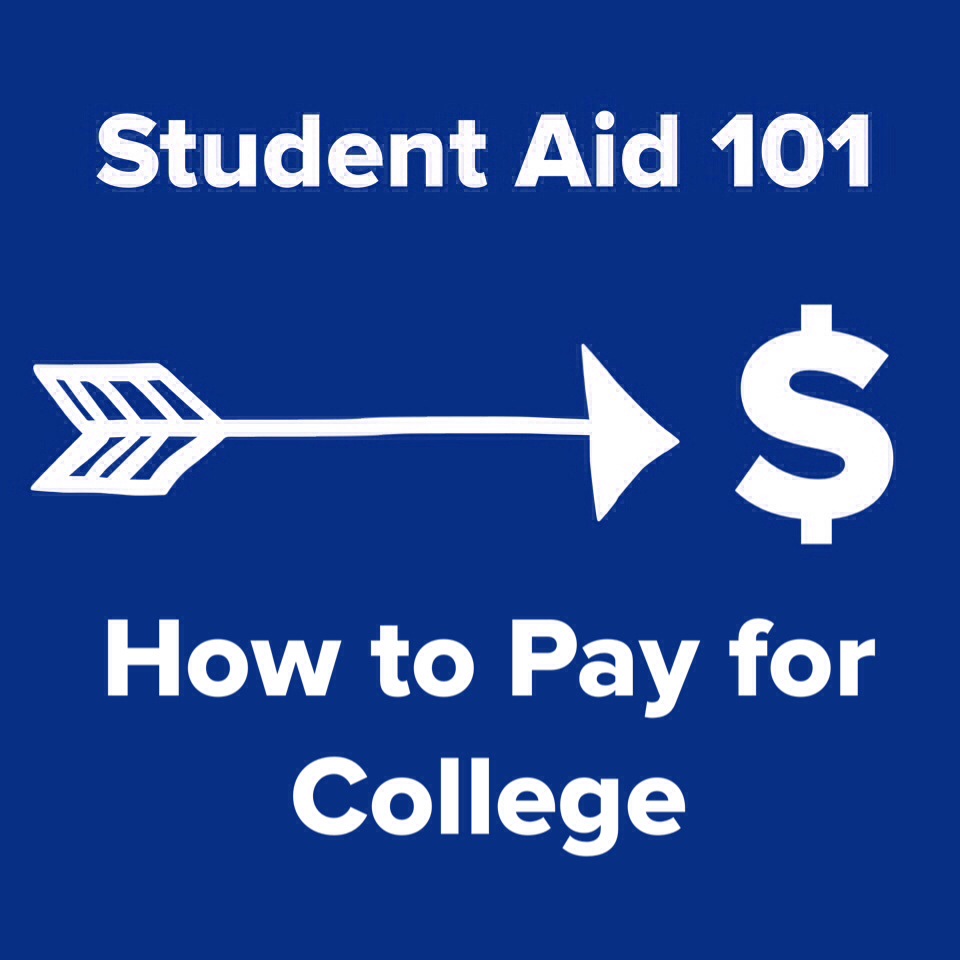
Student Aid 101

Getting the most from your financial aid and student loan options can make a big impact on how you pay for your education. Our guide can help you navigate your options in paying for college.
What Parents and High School Students Need to Know
- How do I file for financial aid?
- Where can I get help with my FAFSA?
What Current College Students and Recent Graduates Need to Know - What is a Pell Grant?
- Where can I find other grants and scholarships?
- Where can I get student loans?
- What is work-study?
- Private Student Loans
- What are my repayment options?
- What is a Stafford Loan?
- Alert about Rip-offs
- How do I consolidate my student loans?
- How do student loans affect my taxes?
- How do I know my payback amounts for student loans?
- Can I postpone repaying my student loans?
- Can I cancel my student loans?
- What if I default?
How do I file for financial aid?
At the start of each calendar year when you are a senior in high school or when you are enrolled in college, you need to fill out a form called a FAFSA in order to start the process to receive financial aid. The FAFSA, or Free Application for Federal Student Aid, is necessary in order to qualify for federal grants, loans and work-study, you must complete a FAFSA. You can get an estimate of the kind and amounts of financial aid for which you may be eligible before you finish an entire application with the Department of Education’s tool, the FAFSA4caster. Once you have completed a FAFSA, you should consult the financial aid office at your school or at schools you are interested in attending to see what other campus-specific assistance you can get.
FAFSA applications deadlines are updated each year and can be found at the Department of Education.
Where can I get help with my FAFSA?
The Department of Education, which administers the FAFSA, has three ways of getting help with your student aid:
- A live chat forum where you can ask questions.
- A hotline at 1-800-4FED-AID (1-800-433-3243)
- And a customer service email address: [email protected]
What is a Pell grant?
A Federal Pell Grant is a student aid program based on the financial need of students which, as a grant, does not have to be repaid. The amount you may receive from a Pell Grant can be as high as $5,645 per year (for 2013-2014) depending on your financial need, costs to attend your school and whether you will be in school full time. The first step in qualifying for a Pell Grant is completing a FAFSA application.
Where can I find other grants and scholarships?
There are three significant federal grant programs other than the Pell Grant program. You may also want to consider grants and scholarships outlined by the Oregon Student Access Commission.
Other Federal Grants:
If you qualify for a Pell Grant, you will receive priority for another federal grant, called the Federal Supplemental Educational Opportunity Grant (FSEOG). It is made available to students with high financial need who do not already have a college degree. This grant is run by each college’s financial aid office so the availability of the money can vary by campus and by year. The maximum for an individual per year available through the FSEOG is $4,000. For more info consult the Department of Education.
If you want to be an elementary or secondary school teacher or work in certain educational services you may qualify for the Teacher Education Assistance for College and Higher Education Grant (TEACH), administered by the federal government, if you agree to serve as a teacher in schools that serve low-income children and in a field that is considered “high need.” Examples of high need fields include math, reading specialists, special education, and bilingual education. For other examples of teaching fields that may qualify for the TEACH Grant, consult the Department of Education.
If one of your parents or guardians was killed while as a result of serving in Iraq or Afghanistan and you were 24 years old or younger or enrolled in college at the time of your parent or guardian’s death, you may be eligible for the Iraq and Afghanistan Service Grant. This maximum you might receive from this grant is equal to the maximum for the Pell Grant of each year ($5,645 for 2013-2014). Another condition for this grant is that you cannot be eligible to receive a Pell Grant based on the amount of money your family is expected to be able to contribute to your education, or your “Expected Family Contribution.” You can lean how much your family is expected to contribute through the FAFSA application process but for an estimate you can consult the calculator at FinAid.org .
Other Grants and Scholarships Available in Oregon:
The Oregon Student Access Commission (OSAC) maintains a list of many scholarships and grants for which you may be eligible. Before considering loans, complete a FAFSA and then scan through the OSAC list and apply for any grants and scholarships for which you qualify.
Notable grants available through OSAC include:
- The Oregon Opportunity Grant, a need-based grant of up to $2,000 for Oregon residents
- The Oregon Student Child Care Grant, a need based grant of up to $10,000 per year for parents with children who are under the age of 12 with the award amount depending on the number of children you have, their age and what you actually pay for child-care.
- The Oregon Community Foundation: offers many grants through OSAC including for vocational students. These grants average $2,700.
- The Ford Scholars Program: for Oregon residents or residents of Siskiyou County, California. Each year 120 students are selected as Ford Scholars and receive a need-based award of up to 90% of financial need you still have after any other forms of financial aid you receive and with a limit of $25,000 per year. Other eligibility requirements apply such as the need to have a minimum cumulative high school GPA of 3.0 or GED of 2650, attend school full-time, contribute $1,000 toward meeting your financial need from working, seek a bachelors degree without having earned a previous bachelors degree and either have no felony convictions or have completed the terms of any felony conviction.
- The Ford Opportunity Scholarships Program: for single-parents with dependent children under the age of 18 without a domestic partner who either have no felony convictions or have completed the terms of any felony conviction. This scholarship has all the same benefits of the Ford Scholars Program.
- The Ford Re-Start Scholarship Program: for people who are 25 years or older and are seeking a certificate, a 2-year associate’s degree, or a bachelor’s degree and who either have no felony convictions or have completed the terms of any felony conviction.. This scholarship has all the same benefits of the Ford Scholars Program. You can find the deadlines for OSAC Scholarships through the Department of Education.
Where can I get student loans?
Start with federal and state loan programs as they are almost always less expensive and will have better terms, including income-based repayment plans and easier ways to get out of default. None of the protections made available through federal loans are available with private student loans. After filling out a FAFSA, you may qualify for several types of federal student loans:
- Direct Subsidized Loan: For undergraduates who are at least half-time students and have lower incomes, getting a Direct Subsidized loan means that you will not have to pay interest on the loan while you are in school and for six months after you leave school. With a Direct Subsidized Loan, the federal government is directly lending you money.
- Perkins Loan: For undergraduate, graduate, and professional students with financial need, the Perkins Loans offer up to $5,500 per year. Perkins loans are limited from school to school because you are receiving the loan from the school where you are enrolled. Completing all your financial aid applications earlier can help you qualify for a Perkins loan since there is a limited amount of money available each year per school.
- Direct Unsubsidized Loan: Both undergraduates and graduate students regardless of income can receive Direct Unsubsidized loans which have a relatively low interest rate of 3.86%. With Direct Unsubsidized Loans, you are responsible for paying the interest on the loan while you are in school.
- Direct PLUS Loan: If you are an undergraduate and depend on your parents or guardians financially, your parents or guardians can file for a Direct PLUS Loan. If you are a graduate student you can file for a Direct Plus loan on your own. In order to receive a Direct PLUS loan you must have decent credit history, meaning that you have not missed significant payments to your credit card, car loan or other debts that you owe. For more information on what affects your credit see our guide at the OSPIRG Students website.
What is work-study?
If you have financial need you may be eligible for federally supported work-study jobs, part-time positions that allow you to earn money while you are in school. The jobs can be on campus or off campus and the pay depends entirely on what specific position you have. The total number of hours you can work, and the amount of money you can earn, is limited based on how great your financial need is. After completing a FAFSA, you should consult your school’s financial aid office to apply for work-study jobs.
Private Student Loans
Private student loans are loans that students can get from banks and other lenders to help pay for college. Only after exhausting your ability to get grants, scholarships and government backed loans should you consider private student loans. The reason is that private student loans almost always cost more and have none of the protections for you as the borrower that are available through federal or state loans. Here are a few examples of why federal and state loans are almost always preferable:
- You can qualify for income based repayment programs with federal loans, meaning that the amount you will have to pay back will be based on how much you earn. Private loans do not offer this protection.
- The interest rate or cost of taking out a loan, for federal loans is fixed, meaning that it cannot change during the term of your loan. The cost of taking out a private loan can increase over the course of the loan as interest rates can be increased.
- No federal loan currently available has an interest rate higher that 6.41% whereas private student loans can cost you upwards of 18% interest. That means that for every $100 you borrow you might have to pay almost $12 more to borrow from a private lender than from the government.
- Students with private student loans are often responsible for paying the loans back while they are still in school, whereas federal loans do not require you to pay back what you borrow while you are still enrolled.
- Several kinds of federal and state loans are subsidized, meaning that you will not pay the full cost of the loan since you may not have to pay the cost of interest while you are in school. As indicated above, benefits of federal loans can include not having to pay interest on loans while you are in school or being able to deduct your interest payments on your taxes.
What are my repayment options?
If you have borrowed through federal loans, you have several repayment options including plans that are based on your income, which is a major advantage of federal loans over private loans. To enroll in any repayment plan, you should contact your loan servicer, the company that collects payments on your loan. You can find your loan servicer through the Department of Education. Here are some of the repayment plans available for federal student loans:
Standard: All Direct Subsidized, Unsubsidized and PLUS loans qualify for a Standard Repayment plan.
- You pay a fixed monthly amount over the course of 10 years.
- You pay less interest overall compared with plans that lengthen your payback period but you may also pay a higher monthly amount compared to other plans.
- Monthly payments are not based on your income.
Income Based Repayment (IBR): If the amount you owe on your loans in the Standard Repayment Plan every year exceeds 15% of the difference between your income and 150% of the poverty line for your family size where you live, you may be eligible for Income Based Repayment.
- Your monthly payments are usually lower than other payback plans and your payback period is extended to up to 25 years.
- The amount you pay per month may change each year as it is annually readjusted based on your income and family size.
- If the amount you would pay under IBR is less than the monthly cost of interest on your loan, the federal government pays the remaining amount of interest you cannot pay for up to three years.
- After 25 years of making payments under IBR, you may be eligible for forgiveness of the rest of your debt, although you may have to pay taxes on the amount forgiven.
- The tradeoff for lower monthly payments is that you will have to pay more in interest costs over the course of the loan than in a standard, shorter payback period.
- In IBR, your monthly payment will be 15% of your discretionary income, or your income minus the essential living costs calculated for the poverty rate for your family’s size. For example, The Project on Student Debt describes a married person who is making $50,000 per year and has one child while owing $60,000 in student loans. For this person to make the 10-year standard plan payments, he or she would pay $690 per month whereas in an IBR this person would pay $282 per month at the start of the plan, rising as that person earned more money per year.
- PLUS Loans made to parents or Consolidation Loans that include PLUS loans made to parents are not eligible for IBR.
Pay As You Earn: Pay As You Earn, like IBR, is based on your income level. If the amount you owe on your loans in the Standard Repayment Plan every year exceeds 10% of the difference between your income and 150% of the poverty line for your family size where you live, you may be eligible for Pay As You Earn.
- As with IBR, your payments will adjust annually based on your income and family size.
- If the amount you would pay under IBR is less than the monthly cost of interest on your loan, the federal government pays the remaining amount of interest you cannot pay for up to three years.
- Your monthly payment will be 10% of your discretionary income, or your income minus the essential living costs calculated for the poverty rate for your family’s size.
- Your payback period is 20 years.
Income Contingent: If you do not qualify for IBR or Pay As You Earn, you may still be able to make your payments be based on your income.
- You pay based on your income, family size and how much you owe.
- You will not pay more than 20% of your monthly discretionary income.
- If your monthly payment does not cover your interest costs, your loan cannot increase beyond 10% of the original balance due to the “capitalization” of your interest, the addition of the unpaid interest to the principal of your loan.
- Your payback period is 25 years
- If you have not paid the entire loan after 25 years of payment, the remaining debt can be forgiven, though you may pay taxes on the amount forgiven.
Income Sensitive Repayment Plan: If you have certain loans under the former Federal Family Education Loan (FFEL) program, including the Subsidized or Unsubsidized Federal Stafford Loans, FFEL PLUS or Consolidation loans, you may be eligible to enroll in a repayment program based on your income. The payments are made over 10 years.
Graduated: If you have financial need immediately following graduation but you expect that your income will rise steadily, you can enroll in a Graduated Repayment Plan.
- Your payments will be low initially and will increase every two years.
- Your payback period will be 10 years unless you consolidate your loans, in which case you may have up to 30 years to pay back your loans depending on how much you owe.
- Payments in are not based on your actual income.
Extended: If you have more than $30,000 of Direct Loans, you can enroll in an Extended plan.
- You pay back the loans over 25 years.
- You have lower monthly payments but will pay more in interest over the course of the loan.
- Payments are not based on your income.
To compare your repayment options for federal loans, use the Department of Education’s Repayment Estimator.
What is a Stafford Loan?
Stafford loans were once a program in which private lenders sold loans that were backed by the federal government and held by students. However, as of July 1, 2010 Stafford loans are no longer a program backed by the federal government.
Alert about Rip-offs
Beware websites like “www.staffordloan.com” and other sites that look like official government sources but are in fact just private loans. There are many websites like this that seem like one of the official federal or state student loan programs. Be sure to read the bottom of web-pages to ensure that you are at an official government webpage when applying for any of the federal or state backed student loans.
How do I consolidate my student loans?
Consolidating loans means combining the various loans you have into one regular payment. Before you consolidate loans, check the terms of the loans you currently have because consolidation can cause you to pay higher interest rates and lose some benefits depending on the program. If you believe consolidation is the best option for you, several federal loan programs are eligible for consolidation so that you can simplify your payments. A “Direct Consolidation Loan” allows you to combine any of the federal loans made to you personally, though not a PLUS loan made to your parents.
How do student loans affect my taxes?
Certain kinds of debt from student loans can be deducted from your taxes depending on your tax status and your state of residence. American Student Assistance, a non-profit that helps students with student loan debt, provides tax information for student loan borrowers.
For federal taxes:
- Up to $2,500 of the interest you pay on student loans may be deducted from your taxes if:
- You are not a dependent
- You have an income of less than about $75,000 or $150,000 if you file jointly
- Your tuition and school fees may be deductible depending on your income. If:
- You have an income of less than $65,000 or $130,000 if you file jointly, you may deduct up to $4,000
- You have an income between $65,000 and $80,000 or $130,000 and $160,000 if you file jointly, you may deduct up to $2,000
- If you make more than $80,000 ($160,000 jointly) you cannot deduct for school expenses.
- Your employer can provide education assistance benefits of up to $5,250 to go toward tuition, fees, or other school supplies. If you pay these expenses, you may be eligible to deduct them under the category of “employee business expense.”
- Unless you are married and file separately or you have already taken a tuition and fees deduction, you may take educational tax creditssuch as:
- The Lifetime Learning Tax Credit: for each year you enrolled you can take up to $2,000 as a credit if your income is under about $50,000 ($100.000 for joint-filing). You may also qualify for some credit if your income is between $50,000 and $60,000 ($100.000 to $120,000 for joint-filing).
- The American Opportunity Credit: While you are enrolled at least half-time as a student as an undergraduate, you can take up to $2,500 as a credit if your income is less than about $80,000 ($160,000 for joint filing). If you have an income between $80,000 and $90,000, you may still be able to claim some credit. If this credit exceeds the amount you owe in taxes, you may be able to get up to 40% of this credit amount as a refund.
For Oregon taxes:
If you are a year-round Oregon resident you cannot claim additional student loan interest or tuition and fee deductions beyond the federal deduction on your state taxes. If you are a part-time resident in Oregon or a non-resident who earned income in Oregon, you may claim some deduction with the following formula: your Oregon-based income divided by your total income multiplied by the federal deduction. The total amount you deduct in Oregon cannot be more than the federal limit for any deduction, as indicated by the Oregon Department of Revenue.
How do I know my payback amount for student loans?
The best way to learn what you currently owe on your student loans is by checking the National Student Loan Database at nslds.ed.gov. You can also ask your school’s office of financial aid. If you have private loans you should consult your lender.
Can I postpone repaying my student loans?
Possibly. You should discuss your options with your lender. You may qualify for a “deferment,” meaning you do not have to pay back your loans for a limited period of time.
You may be eligible for deferment if:
- You are in school for at least half-time
- You are unemployed or you cannot find full employment for up to three years
- You are in a service program such as the Peace Corps in which you have a financial need
- You are an active-duty member of the armed forces during a military engagement, for 13 months after a military engagement in which you served or until you go back to school.
You may also qualify for forbearance. Forbearance means that you can either stop paying for your loans or reduce your payments for up to a year for federal loans although you will continue to pay for the loan by accruing interest. You have to request forbearance from the organization to which you pay your loan payment, called the loan servicer. According to the Department of Education, you may be eligible for forbearance if:
- You have “financial hardship” and/or “illness.”
You may qualify for “mandatory forbearance,” meaning your lender must allow your forbearance if:
- Your total monthly payment is more than 20 percent of your monthly income before taxes
- You are completing a medical or dental internship or residency
- You are part of a service program such as AmeriCorps
Can I cancel my student loans?
Usually no. But depending on what kind of work you do and how much money you earn after you graduate, you may qualify for eventual loan forgiveness or cancellation.
- Public Service Loan Forgiveness: If after you graduate you work for a federal, state, or local government agency, or if you work for a non-profit that qualifies for tax-exempt status as what is called a “501(c)(3)” then you may qualify for the Public Service Loan Forgiveness program. Other organizations that do work such as public interest law, assisting the disabled and other social services may also qualify even if they are not tax exempt. Under this program, you may be eligible to cancel your student loans after 10 years of making on-time payments in full. If you are considering going into public service or public interest work, you will want to set up your payments through one of the qualifying payment programs for public service forgiveness which you can find at the Department of Education’s website.
- Income Based Forgiveness: After 25 years of making payments under an Income Based Repayment Plan, you may be eligible for forgiveness of the rest of your debt, although you may have to pay taxes on the amount forgiven.
- Teacher Loan Forgiveness: If you teach for five consecutive years in a school that serves students in financial need, or at an agency that serves financially needy students, you may be eligible for forgiveness of up to $17,500 of your loans.
- Disability Discharge: If you are totally and permanently disabled as certified by the Veterans Administration, by the Social Security Administration through receiving Social Security Disability Insurance or Supplemental Security Income or if you are certified by a physician as being incapable of working for the next 5 years, you may be able to discharge your loans.
- Other programs: If your school closed while you were enrolled or within three months of when you graduated, if you go into bankruptcy and satisfy certain requirements or under some circumstances where your school falsely certified your eligibility to receive a loan, you may be eligible for discharge.
If you are going to be a teacher after you graduate you may qualify for loan forgiveness. If you receive a Perkins loan, you may qualify for loan cancellation if you teach students from low-income backgrounds, or if you teach special education or another “high-need” field, defined by your state’s education agency.
What if I default?
If you default on federal loans you can restore your credit by rehabilitating your loan. Here’s how:
Once you are in default on a federal loan, contact your loan servicer to negotiate a rehabilitation program. This will involve you making payments at the level you negotiate and then your loan may be bought by a lender. You may have to pay collection costs in addition to your original debt. You must contact the loan servicer about rehabilitation, so for Federal Perkins Loans, you will need to contact the school from which you borrowed.
There are several advantages to rehabilitating your loan instead of staying in default. By going through rehabilitation you:
- Can help restore your credit. This can help you as an applicant for some jobs as employers sometimes check your credit history and it can also help you to get other kinds of loans in the future, such as a mortgage or a car loan.
- Can choose among repayment plans,
- Become eligible for loan forgiveness,
- Can enter deferment or forbearance
- Can apply for additional federal student aid.
- End any garnishment of your wages or withholding of your income tax refund
More tips:
You can find more resources on this and other consumer issues at the OSPIRG.org
For more information on student aid such as a tool to compare different aid packages from colleges, visit the Consumer Financial Protection Bureau’s website at www.consumerfinance.gov.
To learn more about your individual eligibility for federal programs, consult the Department of Education’s Student Aid website at studentaid.ed.gov.
The advice in this resource is based on information publicly available through the Department of Education, the Oregon Student Access Commission and the Consumer Financial Protection Bureau.
Topics
Find Out More


Trouble in Toyland 2023

VR risks for kids and teens

